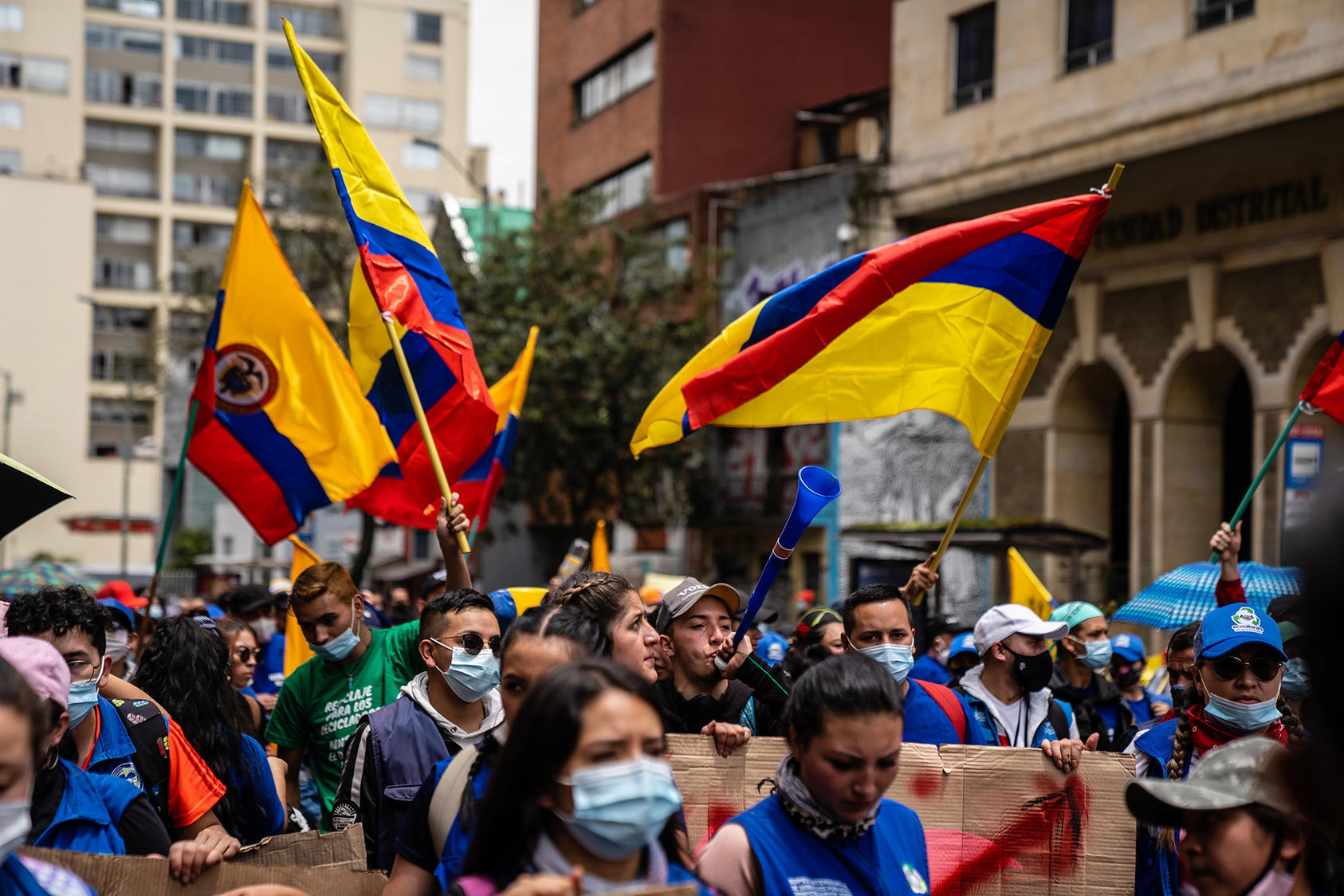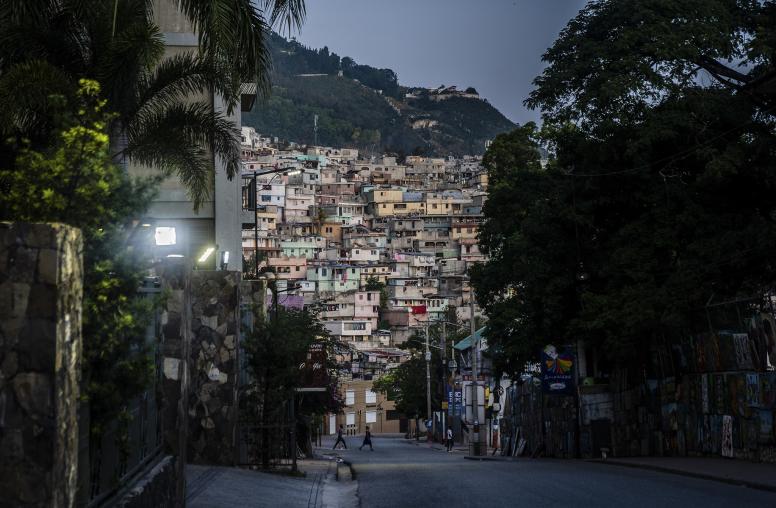Colombia’s National Strike: Inequality and Legitimacy Crises Drive Unrest
National negotiations made initial progress, but the diversity of local grievances and leadership is a major challenge to comprehensive solutions.
After Colombia’s government proposed new tax hikes, social organizations and movements called for a national strike on April 28 across the country. Protesters believed the new fiscal policy — which the government said was aimed at mitigating the pandemic’s economic impact — would disproportionately hurt poor and vulnerable sectors of society. Although the marches and mass gatherings were initially widespread and peaceful, security forces cracked down on demonstrators accused of taking part in vandalism, killing at least 43 and injuring hundreds more. Meanwhile, pre-existing and resulting anger among some groups of protesters led to attacks on security forces and police stations, setting off a cycle of violence.

Since the tax bill was formally withdrawn, the focus of protests has expanded to a wider range of perceived grievances and injustices across the diverse country, while the national government has sought to begin negotiations with the National Strike Committee in Bogotá. USIP’s Steve Hege discusses the evolution and impact of the unrest and violence, the alleged role of armed groups and the prospects for a comprehensive solution to the current crisis.
What are the origins and evolution of the recent turmoil that has beset Colombia since late April?
Outside of its ongoing — and largely rural — armed conflict dating back to the early 1960s, Colombia is now experiencing the most turbulent and violent period of social protest and urban unrest in its modern history. Sending sparks over a tinderbox of racial and socioeconomic inequality, pandemic-related anxieties and political frustrations, initially peaceful marches against a tax reform bill on April 28 organically morphed into widespread anger and resentment over a broad range of perceived injustices.
Since November 2019, two previous periods of mass protests and unrest were largely left unresolved, with unproductive and abandoned attempts at dialogue leaving a ticking time bomb. The country has simultaneously experienced significant surges in political and criminal violence, both within and beyond the nebulous limits of the armed conflict, with massacres and killings of social leaders spiking over the last year.
With some of the world’s lengthiest pandemic lockdowns combined with insufficient social welfare support, Colombia’s acute inequality — among the worst in the world — has been exacerbated. Entrenched, rigid socioeconomic stratification and limited opportunity have engendered deep frustration and hopelessness among Colombia’s youth. Consequently, an important segment of the population fundamentally does not currently believe in the legitimacy of the Colombian state or trust its political and economic elites.
Why has there been such significant levels of violence during the unrest?
Largely peaceful mass gatherings and marches have been accompanied or followed by aggressive confrontations with overwhelmed security forces and indiscriminate attacks on public infrastructure and government institutions by a sub-set of enraged protesters. Initial efforts to avert the further escalation of the crisis at its outset were largely ineffective, in part, due to security forces’ heavy-handed tactics, including incidents of abuses and the killing of protesters, which only reinforced pre-existing animosities toward the state.
Indignation at these violent clashes with police deteriorated tensions and has given life to renewed calls for accountability and security sector reform while turning many small police stations into the object of rage and vandalism. Recent efforts to revamp the police have yet to take up root as legislation has waned in Congress and internal plans to alter the militaristic posture and ethos of the institution — including a change to more civilian blue uniforms and the use of body cameras — have not yet been enacted.
Have illegal armed groups, criminal or otherwise, been involved in the unrest?
The plethora of armed groups that have continued to expand throughout Colombia in recent years, despite the historic 2016 peace deal with the FARC, have indeed been accused of orchestrating some violence and unrest. While no doubt their local commanders continue to seek to take advantage of the crisis, and have apparently led arson attacks on local court buildings, if these groups had the intention and capacity to alone generate such levels of national turmoil they would have certainly done so on numerous previous occasions.
When 70 police stations were attacked in the massive unrest in Bogotá last September, the attorney general was only able to find evidence of a small number of individuals linked to armed groups who were involved in two locations. In this current crisis some criminal groups are actually targeting protesters blocking key routes for illicit trafficking between Cali and the strategic port city of Buenaventura.
More concerning though is the reality that enraged and disillusioned youth are likely to be prime targets for recruitment by armed and criminal groups should the strike not result in their demands being redressed to a degree which would have justified the sacrifice and trauma of this past month.
On the other hand, general fear and mistrust have also been exacerbated by the police’s infiltration of protesters with undercover agents as well as the emergence of groups of armed civilians targeting protesters, hearkening back to the country’s dark history of paramilitarism. These have galvanized social media calls for “good people” to take up arms and resist what they view as an uncontrollable popular uprising threatening their interests. Indiscriminate attacks on indigenous marches by such groups in Cali and subsequent violent responses have also deepened racial tensions, with many elites calling on indigenous groups to “return to their reserves,” in reference to colonial-era policies of second-class citizenship.
What has been the economic and public health impact of the turmoil?
The escalation of the crisis created confrontational frontlines throughout the country, notably in its third largest city of Cali. Despite efforts at ensuring “humanitarian corridors,” roadblocks mounted by protesters have been viewed as generating scarcities of gas, food and oxygen tanks amid surging COVID cases. The losses for local farmers throughout much of the southwest of the country have indeed been significant. Attempts to dismantle many roadblocks with overwhelming military force, however, have only heightened tensions and undermined efforts to build the minimum levels of trust necessary for dialogues and negotiations. There remains important divergence of understanding and ambiguity within Colombia as to the acceptable parameters of peaceful protest and the limits of the common practice of impeding mobility and commerce. This has been a crucial component of the initial talks between the government and the National Strike Committee.
What are the prospects for solutions to the current crisis?
Countless voices have repeated calls for dialogue, yet the fresh wounds of violence, demands for justice, as well as the broad nature of popular resentment and frustration emerged as important challenges in initial talks. There is also widespread mistrust of the government after efforts to resolve previous protests have not been perceived to have led to concrete outcomes. Early on, the strike leaders made demands for substantive negotiations around a concrete agenda and not just ambiguous dialogue or listening sessions, which social leaders fear can simply deflate momentum.
It appears that the National Strike Committee is now finally on the verge of reaching a pre-accord with the government that outlines a substantive negotiations agenda with seven thematic categories that they will undertake soon, along with some important consensus regarding the guarantees for the right to peaceful protest. However, as strikes, marches and road blockades continue, the actual impact of a national agreement in Bogotá on frontline protesters in cities like Cali remains unclear. While the National Strike Committee has attempted to generate more inclusiveness and ensure greater buy-in on the substance of its engagement with the government, the dramatic diversity of local demands that have been galvanized by the crisis requires the adoption of more complex multi-level processes with mechanisms incorporated specifically for subnational leaders to forge actionable, concrete agreements. Some protest leaders and prominent universities have even been clamoring for a deeper decentralization of democratic and participatory decision-making structures, which go beyond the limits of the 1991 constitution and bypass traditional national political elites to tackle long-standing challenges, such as the power of mayors over the national police.


